 W
WActinodendron arboreum, commonly known as tree anemone or hell's fire anemone, is a species of sea anemone in the family Actinodendronidae. It is native to the Indo-Pacific where it grows at depths of down to 28 metres (92 ft). Most sea anemone species are harmless to humans, but A. arboreum is highly venomous and its sting can cause severe skin ulcers.
 W
WActinoporus is a genus of sea anemones of family Aurelianidae. It comprises the following species:Actinoporus elegans Actinoporus elongatus
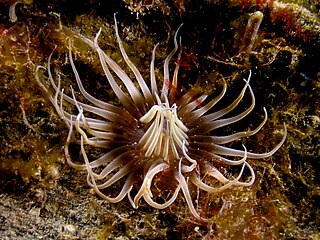 W
WActinostephanus haeckeli is a species of sea anemone in the family Actinodendridae.
 W
WActinostola is a genus of sea anemones in the order Actiniaria. Members of this genus are deep sea species, with some occurring at hydrothermal vents.
 W
WActinostola callosa is a species of sea anemones in the family Actinostolidae in the order Actiniaria. It is a deep sea species and occurs in both Pacific and Atlantic Oceans from the continental shelf to abyssal depths.
 W
WActinostolidae is a family of sea anemones in the order Actiniaria. Members of this family are deep sea species, with some occurring at hydrothermal vents.
 W
WActinostoloidea is a superfamily of sea anemones in the order Actiniaria.
 W
WActinothoe sphyrodeta, the sandalled anemone, is a small sea anemone in the family Sagartiidae. It is native to the northeastern Atlantic Ocean and is common on the north, west and south coasts of Britain. It is usually grey or whitish but may have an orange oral disc. The translucent white tentacles that grow around the edge of the oral disc can number up to 120.
 W
WAiptasia is a genus of a symbiotic cnidarian belonging to the class Anthozoa. Aiptasia is a widely distributed genus of temperate and tropical sea anemones of benthic lifestyle typically found living on mangrove roots and hard substrates. These anemones, as well as many other cnidarian species, often contain symbiotic dinoflagellate unicellular algae of the genus Symbiodinium living inside nutritive cells. The symbionts provide food mainly in the form of lipids and sugars produced from photosynthesis to the host while the hosts provides inorganic nutrients and a constant and protective environment to the algae. Species of Aiptasia are relatively weedy anemones able to withstand a relatively wide range of salinities and other water quality conditions. In the case of A. pallida and A. pulchella, their hardiness coupled with their ability to reproduce very quickly and out-compete other species in culture gives these anemones the status of pest from the perspective of coral reef aquarium hobbyists. These very characteristics make them easy to grow in the laboratory and thus they are extensively used as model organisms for scientific study. In this respect, Aiptasia have contributed a significant amount of knowledge regarding cnidarian biology, especially human understanding of cnidarian-algal symbioses, a biological phenomenon crucial to the survival of corals and coral reef ecosystems. The dependence of coral reefs on the health of the symbiosis is dramatically illustrated by the devastating effects experienced by corals due to the loss of algal symbionts in response to environmental stress, a phenomenon known as coral bleaching.
 W
WAiptasia mutabilis, also known as the trumpet anemone, rock anemone, and glass anemone, is a species of anemone typically found attached to substrates in cold waters of the Atlantic Ocean. Its unique trumpet shape gives it its common name and it can grow to be 12 cm, having a column between 3 and 6 cm in size. Like many cnidarians, they rely on nematocysts for protection and to capture prey. They are not difficult to care for, and can be kept in a home aquarium, although due to their speed of reproduction, can quickly become overpopulated.
 W
WAiptasiidae is a family of sea anemones, comprising the following genera:Aiptasia Gosse, 1858 Aiptasiogeton Schmidt, 1972 Bartholomea Duchassaing de Fonbressin & Michelotti, 1864 Bellactis Exaiptasia Grajales & Rodriguez, 2014 Laviactis Grajales & Rodriguez, 2014 Neoaiptasia Parulekar, 1969 Paraiptasia England, 1992 Paranthea Verrill, 1868
 W
WBartholomea is a genus of sea anemones in the family Aiptasiidae.
 W
WBartholomea annulata is a species of sea anemone in the family Aiptasiidae, commonly known as the ringed anemone or corkscrew anemone. It is one of the most common anemones found on reefs in the Caribbean Sea.
 W
WBoloceroides is a genus of sea anemones in the family Boloceroididae. It contains the following species:Boloceroides daphneae Daly, 2006 Boloceroides hermaphroditica Carlgren, 1900 Boloceroides mcmurrichi (Kwietniewski, 1898)
 W
WBoloceroides mcmurrichi is a species of sea anemone in the family Boloceroididae.
 W
WCryptodendrum is a genus of sea anemones in the family Thalassianthidae. It is monotypic with a single species, Cryptodendrum adhaesivum, also commonly known as the adhesive anemone, pizza anemone, and nap-edged anemone. Like all symbiotic anemones it hosts zooxanthellae, symbiotic algae that help feed their host.
 W
WDiadumene is a genus of sea anemones. It is the only genus in the monotypic family Diadumenidae.
 W
WDiadumene cincta is a small and delicate, usually orange, sea anemone. It has a smooth slender column and up to 200 long tentacles, and normally grows to a length of up to 35 mm (1.4 in), with a base of 10 mm (0.4 in), but specimens twice this size have been recorded. Diadumene cincta is found in the northeastern Atlantic Ocean.
 W
WDiadumene leucolena, commonly known as the white anemone or ghost anemone, is a species of sea anemone in the family Diadumenidae. It is an inconspicuous species found in the intertidal and subtidal areas of the northeastern Atlantic Ocean, the Caribbean Sea and the northern Pacific Ocean. Diadumene, "diadem-bearer", referring to the crown of tentacles, is a female form intended to bring to mind the Diadumenos, the renowned Greek sculpture of an athlete crowning himself with the victor's ribbon diadem.
 W
WDiadumene lineata, the orange-striped green sea anemone, has several morphotypes which have been described multiple times.
 W
WEdwardsiidae is a family of sea anemones. Edwardsiids have long thin bodies and live buried in sediments or in holes or crevices in rock.
 W
WThe Enthemonae is a suborder of sea anemones in the order Actiniaria. It comprises those sea anemones with typical arrangement of mesenteries for actiniarians.
 W
WExaiptasia is a genus of sea anemone in the family Aiptasiidae, native to shallow waters in the temperate western Atlantic Ocean, the Caribbean Sea and the Gulf of Mexico. It is monotypic with a single species, Exaiptasia pallida, and commonly known as the brown anemone, glass anemone, pale anemome, or simply as Aiptasia.
 W
WGonactinia is a monotypic genus of sea anemones, and G. prolifera is the only species in the genus. It is sometimes called the storey anemone and is found on either side of the northern Atlantic Ocean.
 W
WGonactiniidae is a family of anthozoans in the order Actinaria.
 W
WHeteractis magnifica, also known by the common names magnificent sea anemone or Ritteri anemone, is a species of sea anemone belonging to the Stichodactylidae family native to the Indo-Pacific area.
 W
WIsanthidae is a small family of sea anemones in the class Anthozoa.
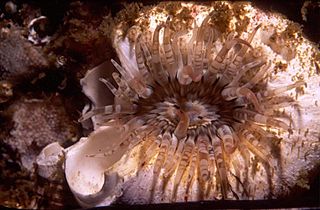 W
WIsanthus is a genus of sea anemones in the family Isanthidae.
 W
WLiponema is a genus of sea anemones, in the family Liponematidae.
 W
WLiponema brevicorne, commonly known as pom-pom anemone or tentacle shedding anemone, is a species of sea anemone in the family Actiniidae. It is a deep water species and has been relatively little observed. It often remains unattached to a substrate and can roll across the ocean floor propelled by water currents.
 W
WActiniaria form an order of animals in the class Anthozoa that includes sea anemones.
 W
WMetridiidae is a family of sea anemones in the order Actiniaria.
 W
WMetridioidea is a superfamily of sea anemones in the order Actiniaria.
 W
WMembers of the genus Metridium, also known as plumose anemones, are sea anemones found mostly in the cooler waters of the northern Pacific and Atlantic oceans. They are characterized by their numerous threadlike tentacles extending from atop a smooth cylindrical column, and can vary from a few centimeters in height up to one meter or more. In larger specimens, the oral disk becomes densely curved and frilly.
 W
WMetridium dianthus is a species of sea anemone in the family Metridiidae. It is found in the northern Atlantic Ocean and in the northeast Pacific Ocean. There is also a record from South Africa, possible resulting from an introduction.
 W
WMetridium farcimen is a species of sea anemone in the family Metridiidae. It is commonly known as the giant plumose anemone or white-plumed anemone. It is found in the eastern Pacific Ocean from Alaska down to Catalina Island, California.
 W
WMetridium senile, or frilled anemone, is a species of sea anemone in the family Metridiidae. As a member of the genus Metridium, it is a type of plumose anemone and is found in the seas off north-western Europe and both the east and west coasts of North America.
 W
WNemanthus is a genus of sea anemones. It is the only genus in the monotypic family Nemanthidae.
 W
WNemanthus annamensis, commonly known as the gorgonian wrapper, is a species of sea anemone found in central Indo-Pacific waters.
 W
WParanthus is a genus of sea anemones in the family Actinostolidae.
 W
WParanthus rapiformis, the onion anemone, is a species of sea anemone in the family Actinostolidae. It was first described by the French naturalist Charles Alexandre Lesueur in 1817 and is native to the northwestern Atlantic Ocean and the Gulf of Mexico.
 W
WPhymanthus crucifer, commonly known as rock flower anemone, flower anemone, red beaded anemone or the beaded anemone, is a species of sea anemone in the family Phymanthidae. It has been described as "closely similar" to Heteractis aurora in several ways, commonly exhibiting "tentacles with swollen cross-bars" bearing large clusters of stinging nematocysts. However, P. crucifer may also be found with smooth tentacles, sometimes in the immediate vicinity of a swollen-crossbarred specimen.
 W
WProtanthea simplex is a species of sea anemone found in deep water off the coasts of north west Europe. It is the only species in the monotypic genus Protanthea.
 W
WThe ring-tentacle anemone is a species of sea anemone in the family Isanthidae.
 W
WSea anemones are the marine, predatory animals of the order Actiniaria. They are named after the anemone, a terrestrial flowering plant, because of the colourful appearance of many. Sea anemones are classified in the phylum Cnidaria, class Anthozoa, subclass Hexacorallia. As cnidarians, sea anemones are related to corals, jellyfish, tube-dwelling anemones, and Hydra. Unlike jellyfish, sea anemones do not have a medusa stage in their life cycle.
 W
WThe sebae anemone, also known as leathery sea anemone, long tentacle anemone, or purple tip anemone, is a species of sea anemone belonging to the family Stichodactylidae and native to the Indo-Pacific area.
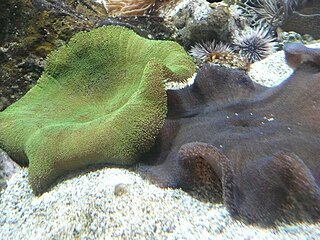 W
WStichodactyla haddoni, commonly known as Haddon's sea anemone, is a species of sea anemone belonging to the family Stichodactylidae. It is found in the Indo-Pacific area.
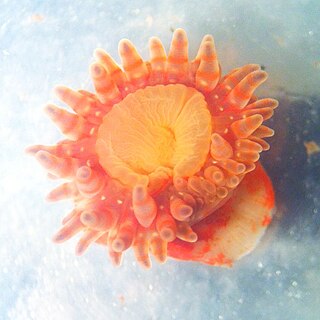 W
WStomphia coccinea is a small reddish, orange or brownish sea anemone in the family Actinostolidae from the North Atlantic, North Pacific and Arctic Ocean. It can swim away when necessary in order to escape a predator.
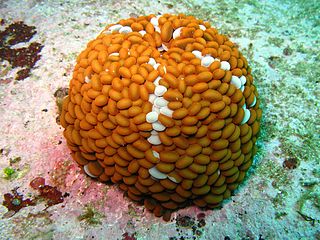 W
WThenaria is an infraorder of cnidarian anthozoans of the suborder Nyantheae, order Actiniaria.
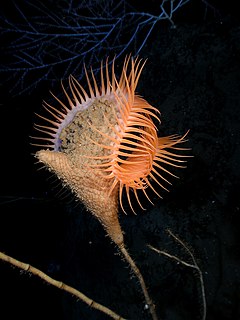 W
WThe Venus flytrap sea anemone is a large sea anemone that superficially resembles a Venus flytrap. It closes its tentacles to capture prey or to protect itself. It is a deep ocean species.